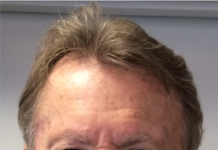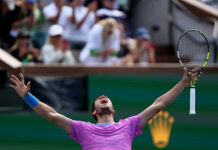By Bill Simons
The late much-celebrated Nelson Mandela had a long and important connection with
sports and tennis, which drew Inside Tennis publisher Bill Simons to Johannesburg. Here is
his account of the Mandela legacy in sports, which we originally published in 2010.
These were sweet days of redemption. In 1994, at last, the weight of South African history – mean and unsparing – had lifted.
Still, questions loomed.
Breaking through the shadow of a troubled land – bright diamonds, ominous fears – a new day was emerging. The singular Nelson Mandela, after 27 painstaking years, was at last free. The dreary clouds of apartheid had parted and in a miraculous election, in which all at last could vote, the onetime revolutionary, ex-convict and terrorist emerged to lead.
But there were questions. Big questions.
The headline was simple: “Mandela Can Win An Election, But Can He Lead?”
Intransigent whites – raging with anger, consumed by fear – were on the brink of a violent counter-revolution. Brutal backlash from bitter-enders, who had seen their once muscular power evaporate, was imminent. Conventional wisdom confidently insisted the streets would soon be stained with blood. But Mandela – ingenious, determined – had a vision: an outside-the-box, all-power-to-the-imagination idea to use sports, of all things, to capture hearts, to unite a nation. Of course, Mandela was that most rare of men who could bring together ruler and ruled, jailer and jailed, militant and gradualist. As much as Reagan or Roosevelt, this “benign Machiavelli” could unleash relentless charm offensives.
Mandela’s master plan was to use mass theater to win whites (and blacks) over to the notion of unity by bowing before the altar of South Africa’s secular religion: Rugby. After all, the national team, the Springboks, had 10 times the cachet of the Dallas Cowboys, New York Yankees and Notre Dame rolled into one. In their green and gold uniforms, they were the athletic gods of the Afrikaners, the white tribe that concocted apartheid in the first place. But while whites adored the beloved burlyman group, blacks bristled openly, rooting against them and organizing an international boycott to neuter a potent symbol of cruelty.
But this was not a time for petty revenge. If the blacks, now flush with power, had merely removed the white’s cultural treasure, the cycle of separation – dreary and unsparing – would just have marched on, locked in place. Instead, Mandela was counter-intuitive. He would use an odd, but powerful weapon – one that heals the soul – forgiveness.
With the World Cup coming to Johannesburg in ’95, he would use the polarizing Springboks to defuse centuries of hatred. Long before “Yes We Can,” his “One Nation, One Team” slogan would evolve from an implausible pipe dream, to a kind of widely accepted “We Shall Overcome” for sports. That accomplished, the less-than-dominant Springboks would have to face New Zealand’s fearsome and favored All-Blacks in the final. And Mandela – brave, harsh, bold – actually had the temerity to show up for the pre-game ceremonies wearing the Springboks’ celebrated No. 6 captain’s jersey. Such madness! For certainly the largely white throng of 62,000 would shower the anti-Christ with disdain and derision. Old colonial flags might unfurl. Whites would never sing the new anthem of the land. And, dare we note, a bomb could have exploded or Mandela could well have met an assassin’s bullet (like Gandhi, Martin Luther King, et al, before him).
Instead, what exploded was an outburst of ecstatic reconciliation. The muscle-bound but at last integrated Springboks actually joined in to sing a Xhosa-language liberation hymn that was now a national anthem, and the crowd in the Ellis Park stadium chanted loud:
“NEL-SON!”
“NEL-SON!”
“NEL-SON!”
Here was a transformative sports moment suggestive of Jessie Owens at Hitler’s 1936 Olympics or Jackie Robinson shattering baseball’s racial barrier in 1947. Alas, the master of forgiveness and reconciliation had molded sport to his purpose. Beaming and confident, his appearance proclaimed “We are all in this together.” And when the Springboks scored a narrow, extra time victory, celebrations (not bombs) exploded from Soweto’s steamy back alleys to the scruffy outback hills of Transkel.
This was the moment.
A nation defined could breathe at last and strive to stumble forward, the path secured. Success was now an option. Without Mandela, such wildly disparate parts would never have merged.
—–
Such a fluke! But those who knew Mandela realized this was no ordinary revolutionary with a “them or us” mindset. Here was a reflective man who clinically studied the language and games of his oppressor and his lifelong love of sports would eventually prove to be not just some pleasant weekend diversion but rather a tool for transformation. Mandela had played some tennis in college, and was a serious amateur heavyweight who idolized Joe Louis. An intense fitness buff, when he was dumped onto a fierce, wind-blown hell they called Robben Island, he would do endless finger push-ups and jog faux-marathons in place in his cell at dawn, much to the consternation of his slumbering cellmates. Eventually, the world’s most celebrated prisoner – No. 466/64 – led a go-slow strike to stop the men from being forced to pound rocks in lime quarries. But, when the authorities relented, the only exercise prisoners got was a dreary half-hour forced march around a cement courtyard, a plight that eventually led to one of the most incongruous moves in the history of sports facility construction: a tennis court was created right in the prison courtyard.
Mandela noted, “Prisoners from the general section painted the cement surface green and then fashioned the traditional configuration of white lines… A net was put up and suddenly we had our own Wimbledon in our front yard…Exercise was unusual for African men of my age and generation…Some of my younger comrades looked at me and said, ‘If that old man can do it, why can’t I?’ They, too, began to exercise…I had played a bit of tennis when I was at Fort Hare [University], but I was by no means an expert. My forehand was relatively strong, my backhand regrettably weak. But I pursued the sport for exercise, not style; it was the best and only replacement for the walks to the quarry. I was one of the first in our section to play regularly. I was a backcourt player, only rushing to the net when I had a clean slam…Being able to play was immensely freeing. Playing tennis and attending to my gardening became my two favorite hobbies…It was a strange sensation enjoying such civilized hobbies in such an uncivilized place.”
A few years later, Mandela would tune in his radio to listen to John McEnroe as he met Bjorn Borg in what some still consider the best tennis match in history, the ’80 Wimbledon final. All the while, the prime international sportsman to campaign against apartheid was none other than the elegant Virginian, Arthur Ashe. Time and again, the spindly conscience of our sport moved to counter apartheid. After he was twice denied entry into South Africa, Ashe played in Johannesburg in ’73, where he demanded the unthinkable. The Ellis Park crowd that would watch had to be integrated. Ashe’s appearance was empowering. One 14-year-old black zealously shadowed the American’s every move. Then when Ashe finally asked why, the boy responded, “Because you are the first truly black man I have ever seen.”
Similarly, writer Mark Mathabane wondered, “How could a black man play such excellent tennis, move about the court with such confidence, trash a white man and be cheered by white people?” Sport itself was proving to be a bomb, shattering mind-sets.
Ashe soon went on to lead the movement to ban South Africa from the ATP and Davis Cup play, and was arrested in Washington, D.C. while protesting apartheid. So it’s not so shocking that Mandela said Ashe would be the first notable he would want to meet once he was free (and indeed the two had a memorable meeting when Mandela visited New York). And when Ashe died in ’93, Mandela called his ally “a citizen of the world,” and “an extraordinary individual who has given me and millions hope at a time when it was needed most…The history of South Africa will not be complete without reference to his fervor.”
Through the years, Mandela sustained his tennis connection. He sketched a widely marketed drawing of his prison court, met with a large delegation of players who held a fundraising tournament in his honor and took McEnroe to see his Robben Island cell. As we recently noted, when Andre Agassi met him, he was particularly struck by Mandela’s ode to mindfulness, his insistence that “we must all care for one another…But also we must care for ourselves, which means we must be careful in our decisions, relationships, statements. We must manage our lives artfully in order to avoid becoming victims.”
More than impressed, Andre said Mandela was “Gandhi-like and void of bitterness. His eyes…were filled with wisdom…[that] said he’d figured something out, something essential.”
Though merely a tennis writer, I had the notion, against all odds, to seek an interview with Mandela. I wanted to hear him reflect on the power of sport and what his fabled prison tennis court was actually like. I wondered what he imagined as Mac and Borg battled on a distant court, what he thought of the elegant dignity of Ashe and did he agree with his fellow freedom fighter Bishop Desmond Tutu, who once told me that, yes, international notables like Arthur played a pivotal role in the fall of apartheid. I wondered what he thought of America and how he would balance the deeds of McEnroe – who was so nasty so often – yet told promoters to take the million dollars they offered him to play in Apartheid Africa and shove it. And, more than anything, I would have wanted to know how he rose above his deep rage to attain his singular serenity, such a transformative calm.
With this in mind in ’99, I shot for the stars and shamelessly sought an interview with the great man. I enlisted friends and power brokers: the heads of the USTA and ATP, the ex-New York mayor, David Dinkins, and the ambassador to South Africa.
Surprisingly, my seemingly futile quest actually gained traction and in 2000, after covering a Davis Cup tie in Zimbabwe, an interview was scheduled. So I trekked down to Johannesburg and checked out Mandela’s two homes: a minimalist, yet inspiring, shanty where he had lived in Soweto, and his current abode, a grand white home with a tennis court in Houghton, a leafy enclave that would seamlessly fit into west L.A.
But, ultimately, fate would scream “Not so fast.” At the last minute, Mandela’s longtime gatekeeper, Zelda, told me my meeting had to be called off because the President was “trying to sort out some little spat. He’s been taken to a peace talk in Burundi where these people unfortunately have taken to shooting each other.”
Oh well. Even a tennis zealot like myself had to concede that resolving the Hutu vs. Tutsi bloodbath (which had already claimed 200,000 lives and left 500,000 homeless) was a tad more important (to say the least!) than reflecting on Borg vs. McEnroe. But never one to throw in the journalistic towel, four years later I again requested to talk with Mandela. When I was again turned down (this time I was told that his “calendar was so full, injudiciously full”), I wondered whether all my effort was just the hubris of a “go for it” dreamer? Or did my “Journey to Mandela” make sense? After all, not only did tennis touch his life with an intriguing regularity, no other political figure had used sports so adeptly to bring the raging masses together. Plus, however futile my quest was, at least it was in the spirit of his most celebrated sentiment, his “dare to be fearless” teaching, which insisted that “our deepest fear is not that we are inadequate. Our deepest fear is that we are powerful beyond measure. It is our light, not our darkness, that most frightens us…Playing small doesn’t serve the world. There’s nothing enlightened about shrinking…We are all meant to shine…It’s not just in some of us; it’s in everyone. And as we let our own light shine, we unconsciously give other people permission to do the same. As we are liberated from our own fears, our presence automatically liberates others.”


















